history Archives - Girls With Guns (original) (raw)
Literary rating: ★★★★
Kick-butt quotient: ☆☆☆☆
 I am, probably, biased here. Scottish action heroines are pretty rare, to the point I am hard pushed to think of a single one I’ve covered previously, in the twenty years I’ve been running this domain. [I just made myself feel very old…] So I was likely disposed to feel kindly towards this literary example. But even setting aside patriotic tendencies, I genuinely enjoyed reading this. It takes place, I’m guessing, around the 9th century, when Scotland was still a loosely connected set of tribes, albeit with a king in what’s now Edinburgh, and a rather fragile peace with the Norse neighbours.
I am, probably, biased here. Scottish action heroines are pretty rare, to the point I am hard pushed to think of a single one I’ve covered previously, in the twenty years I’ve been running this domain. [I just made myself feel very old…] So I was likely disposed to feel kindly towards this literary example. But even setting aside patriotic tendencies, I genuinely enjoyed reading this. It takes place, I’m guessing, around the 9th century, when Scotland was still a loosely connected set of tribes, albeit with a king in what’s now Edinburgh, and a rather fragile peace with the Norse neighbours.
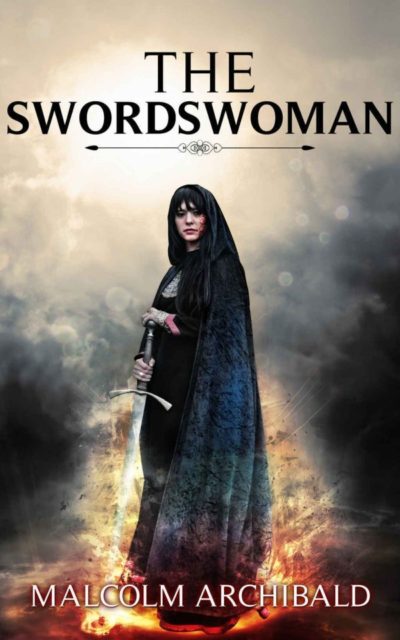 That peace is shattered when someone is washed up on the Western Isles island of Dachaigh where 20-year-old Melcorka lives with her mother. It turns out the Norse are invading, and the king must be notified of the threat. Melcorka and the rest of her clan head towards the capital, only to arrive too late: the army of Alba (as Scotland was then called) has been routed and the nobles scattered. However, Melcorka has a destiny to fulfill… And also inherits a large sword, Defender, with a history dating back centuries, whose powers transform her into the titular character. It’s up to her to rally forces, including the ferocious Picts from the North, to take on the invaders, and send them back across the North Sea to Scandinavia.
That peace is shattered when someone is washed up on the Western Isles island of Dachaigh where 20-year-old Melcorka lives with her mother. It turns out the Norse are invading, and the king must be notified of the threat. Melcorka and the rest of her clan head towards the capital, only to arrive too late: the army of Alba (as Scotland was then called) has been routed and the nobles scattered. However, Melcorka has a destiny to fulfill… And also inherits a large sword, Defender, with a history dating back centuries, whose powers transform her into the titular character. It’s up to her to rally forces, including the ferocious Picts from the North, to take on the invaders, and send them back across the North Sea to Scandinavia.
It’s not quite historical, not quite fantasy: or, rather, this has elements of both. Events occur in real places: fun fact, up until he retired, my father worked in Burghead, the modern site of Pictish capital Am Broch in the book – I grew up less than 20 miles away. I kept found myself going to Wikipedia to look up particular locations, as Melcorka and her allies moved through the country. But there are some elements which are mystical, such Melcorka venturing into Elfhame, the realm of Faery. At least in this volume, those are limited, and the rest feels grounded. Very grounded in some areas, particularly the battle descriptions, which don’t pull punches: “the slide of intestines as blades ripped open bellies and the pink-grey splurge of brains as swords split skulls.”
It’s certainly not all gore though, and Melcorka realizes there’s a gulf between battle as described in the sagas and heroic songs, and the real thing. It’s part of her development as a heroine, which may be this book’s strongest suit. She starts as an innocent, almost naive young woman, takes her lumps and comes out the other side, wiser if not necessarily happier for it. Credit is also due to Archibald for telling a complete, satisfying story without the need for a gratuitous cliff-hanger. That helps leave me much more likely to invest further in the series, as time permits. He has done the country proud, and I look forward to discovering where Melcorka’s destiny will take her.
Author: Malcolm Archibald
Publisher: Next Chapter, available through Amazon, both as a paperback and an e-book
Book 1 of 5 in The Swordswoman series.
★★★½
“The fair sex is your department.”
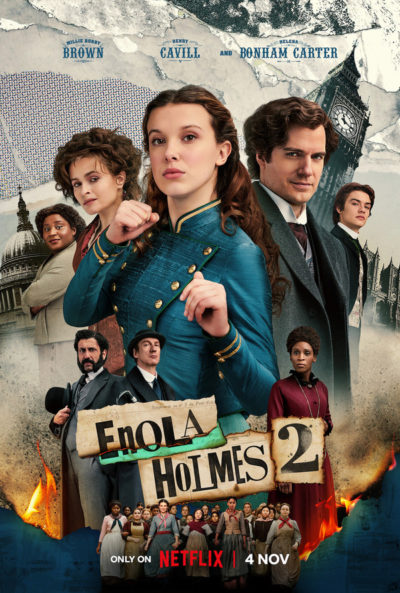 I had forgotten how much I really did not like the original movie. It’s particularly hard to believe, because this sequel is a significant improvement in just about every way. Most of my criticisms from the review seem to have been addressed. For example, the most annoying character, Enola’s mother, played by Helena Bonham-Carter, is all but absent, and the second most useless role, aristocrat Lord Tewkesbury (Partridge), is considerably less irritating, serving an actual purpose. Sherlock Holmes (Cavill) is shown to be the great detective, familiar from Conan Doyle’s stories. Last but not least, Enola (Brown) is a more mature, less precocious character, and even her fourth-wall breaking seems more natural and less an affectation.
I had forgotten how much I really did not like the original movie. It’s particularly hard to believe, because this sequel is a significant improvement in just about every way. Most of my criticisms from the review seem to have been addressed. For example, the most annoying character, Enola’s mother, played by Helena Bonham-Carter, is all but absent, and the second most useless role, aristocrat Lord Tewkesbury (Partridge), is considerably less irritating, serving an actual purpose. Sherlock Holmes (Cavill) is shown to be the great detective, familiar from Conan Doyle’s stories. Last but not least, Enola (Brown) is a more mature, less precocious character, and even her fourth-wall breaking seems more natural and less an affectation.
The story is better too. It begins with Enola, now trying to make her own way as a detective, is engaged to look for a missing young woman, who has vanished from her match factory job, after purloining some documents from the owner’s office. Digging into this brings Enola into a web of corruption extending high up in the government, and eventually overlaps with Sherlock’s investigation into financial irregularities in the Treasury department. Enola finds herself framed for murder by the shadowy Superintendent Grail (Thewlis) of Scotland Yard, and has to avoid the authorities’ grasp, while working with her brother to untangle the web of intrigue. It doesn’t quite all work – the overlap with Sherlock’s case is never well explained – yet it is almost always interesting and entertaining.
The biggest step up is likely Brown’s portrayal of the heroine. Two years is a long time for a teenager: we saw our own daughter go from a problematic 16-year-old to an 18-year-old human being, and much the same transformation has occurred here. Similarly, Enola now seems like an actual person, not the artificial character created for a book. Her relationships – especially with her brother, though also with Tewkesbury – reflect this, and seem like the kind real people would have. The near-absence of showboating feminist Eudoria Holmes helps, though there are still moments that may provoke slight to moderate eye-rolling. I’d say the finale at the match factory falls into this category, and is certainly unnecessary.
The action feels at a slightly lower, or at least, less frenetic level. The main set-piece is Enola’s breakout from prison (this is also where her mum shows up, along with her martial arts teacher sidekick). It’s not bad, though does feel more like a duty, and an add-on instead of an organic part of the movie. The incorporation into the plot of an actual event, the matchgirl strike of 1888, is a nice idea, grounding the plot, though does become a vehicle for some obvious soap-boxing. “Radical” maybe isn’t quite the compliment the film thinks. In the main, however, this was a very pleasant and unexpected surprise, whose 130 minutes seemed considerably shorter. Bring on a third installment, and hopefully sooner rather than later.
Dir: Harry Bradbeer
Star: Millie Bobby Brown, Henry Cavill, Louis Partridge, David Thewlis
★★★
“Prey to win.”
 The latest entry in the Predator franchise has resulted in sharply divided opinions, partly for reasons that I’m not even going to get into. And, for roughly the 11th millionth time, the reality lies somewhere in the middle. It is probably the best entry in the franchise since Predator 2. However, let’s be clear: Sharktopus vs. Whalewolf would also satisfy that criteria. So, let’s dig in. The year is 1719, and the Northern Plains see a new arrival, in the form of an extraterrestrial visitor, looking to test its mettle against any species unlucky enough to cross its path. They could be animal, or human – the latter include both French trappers and the local Comanches.
The latest entry in the Predator franchise has resulted in sharply divided opinions, partly for reasons that I’m not even going to get into. And, for roughly the 11th millionth time, the reality lies somewhere in the middle. It is probably the best entry in the franchise since Predator 2. However, let’s be clear: Sharktopus vs. Whalewolf would also satisfy that criteria. So, let’s dig in. The year is 1719, and the Northern Plains see a new arrival, in the form of an extraterrestrial visitor, looking to test its mettle against any species unlucky enough to cross its path. They could be animal, or human – the latter include both French trappers and the local Comanches.
The heroine is Naru (Midthunder), a young woman who wants to join her brother, Taabe (Beavers), on the tribe’s hunting parties. He and the rest of the tribe are reluctant to let her, preferring to make use of her skills as a healer. However, after they encounter the Predator while hunting a mountain-lion, Naru sneaks off to hunt it on her own, seeking to prove her skills. It’s not long before it becomes clear she has her hands full, simply trying to survive in the treacherous wilderness, and avoid the trappers. Never mind taking on a vicious creature from another planet, in possession of technology far in advance of what’s available to Earthlings, and with a fondness for ripping spines clean out of their owners’ backs.
It’s certainly a fresh and original setting, especially for a SF/action movie, and I’d say the makers deserve credit for using native actors across the board. I will admit to rolling my eyes at some of the early attempts to position Naru as a rebel, which felt severely like the imposition of modern traits onto a historical setting. “Why do you like to hunt?” “Because they think I can’t!” Yeah, you almost get killed. Twice. They have a point. However, once she leaves the camp and sets out on her own journey, the movie hits its stride. By the time the trappers find they are no longer the hunters, but the hunted, it’s clear Naru will need to think outside the box of standard tactics in order to win. You’ll probably have figured out the key, as soon as she mentions that a certain medicinal herb “cools the blood”…
I can kinda see why it went direct to streaming, since some of the CGI effects are of the low-rent variety, and I suspect it was a lot cheaper than the $88 million cost of its predecessor, The Predator. On the other hand, it doesn’t skimp on the old ultraviolence, and that’s the way a Predator movie needs to be. It has to be said, this seems a particularly dumb example of the alien species – fortunately for Naru. It never seems to see her as a threat until it’s too late, clearly being sexist as well as extraterrestrial. Maybe a future installment could feature a female Predator… With all of history now officially in play, the possibilities are almost endless. While still imperfect, credit is due to the makers, for taking a franchise that seemed potentially on its last legs, and giving it new life.
Dir: Dan Trachtenberg
Star: Amber Midthunder, Dakota Beavers, Michelle Thrush, Stormee Kipp
Literary rating: ★★★★★
Heather Day Gilbert (who’s also a Goodreads friend, and one of my favorite writers) earned high marks from me with her earlier Vikings of the New World duology. Here, she teams up with a new-to-me fellow evangelical Christian writer, Jen Cudmore, to deliver another solid work of historical fiction (the opening volume in a projected series) set in the same era. My trade paperback ARC of this novel was generously given to me by Heather herself; no commitment that my review would be favorable was asked for or given.
Our setting here is partly in Viking-ruled northern Scotland (“Caithness”), but mostly in Scandinavia –specifically, in Tavland, a fictional large island west of Norway. (A map of the island is provided, but it has no scale and doesn’t show it in relation to any other body of land. I picture it as about midway between Norway and Iceland, and perhaps about the size of the latter.) Novels set in fictional countries aren’t unheard of (The Prisoner of Zenda comes to mind). In this case, I’d guess the reason for the device is that the authors wanted to be able to depict a Viking polity, but not to have to be bound to the historical personalities or events of any of the actual ones. The time frame is mainly 998-999 A.D. (with a short prologue set in 989). This was a time when Christianity was spreading in the northern lands, but far from universal. So polygamy and concubinage are still legal, as is slavery (and sexual exploitation of slaves). Warfare and violence are common, life expectancy can be short, and women are under a yoke of patriarchy –though in some ways it’s not as heavy a yoke as it is in the more “civilized” lands of the south in that day.
We have two co-protagonists and primary viewpoint characters here, both young women. Tavland native Ellisif, born into a land-owning family, is about 26 in 998, mother of two little girls, pregnant again, and trapped in an abusive arranged marriage. Somewhat younger at around 20, Inara was born in slavery in the islands north of Scotland, to a now-dead Tavish mother kidnapped into slavery some years earlier. Tall and strong, tough-minded and blessed with some sword skills (long story!), we meet her on the Scottish mainland hiding out from her former master. (We learn the backstory behind that only gradually.) Her goal is to become a warrior. (Although relatively rare, shield-maidens weren’t unknown in Viking society, and could be accepted as such on their merits.) Circumstances are about to bring these ladies’ life-paths together. Their viewpoints are supplemented by those of two Tavish male characters, both single: young jarl (a Viking noble title, cognate with the English “earl”) Dagar, who as a teen was engaged to Ellisif, before her parents died in a accident and her oldest brother got the bright idea of selling her like a cow or a mare to her present husband, and ship-builder and occasional warrior Hakon.
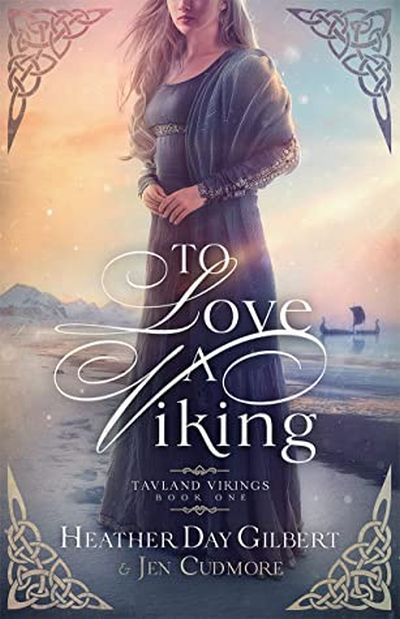 As you’ve no doubt already surmised, yes, this novel does have a romantic component –and, indeed, two romances for the price of one. :-) But it offers more than that, as serious writers know that fiction must if it depicts romantic love as a realistic (and good!) part of the totality of human life; and our two authors here are definitely serious writers. We’re looking here at family life, social relationships, implicit questions of social justice and the relationship of Christian faith to conduct; and we’re also getting a crash course (which sadly is as relevant in 2022 as it was in 998!) in the grim realities of spousal abuse and what is or isn’t a helpful way of dealing with it. (The “Word from the Authors” at the end is constructive in that regard.) Questions of gender roles, and the relationship of career goals vs. family life, are also front-and-center here, and again very relevant.
As you’ve no doubt already surmised, yes, this novel does have a romantic component –and, indeed, two romances for the price of one. :-) But it offers more than that, as serious writers know that fiction must if it depicts romantic love as a realistic (and good!) part of the totality of human life; and our two authors here are definitely serious writers. We’re looking here at family life, social relationships, implicit questions of social justice and the relationship of Christian faith to conduct; and we’re also getting a crash course (which sadly is as relevant in 2022 as it was in 998!) in the grim realities of spousal abuse and what is or isn’t a helpful way of dealing with it. (The “Word from the Authors” at the end is constructive in that regard.) Questions of gender roles, and the relationship of career goals vs. family life, are also front-and-center here, and again very relevant.
One thing that quality historical fiction such as this tends to show is that human nature and needs haven’t really changed over the centuries. (In opposition to that idea, it’s often asserted by modern would-be critics, who know little of history, that romantic love was only invented in the 1700s, and was a concept totally unknown and unimaginable before that. Plenty of primary-source evidence exists to belie that claim; it was not only a known concept, but felt by lots of people, then as now. It just wasn’t always as readily taken into account by people making the decisions about marriages then as now –and, as Ellisif and Dagar would tell us, the ones getting married weren’t always the ones making the decision.) And though this is a “romance,” it’s no bodice-ripper.
The quality of the writing here is very good, and the collaboration is seamless; I’ve read and liked several of Heather’s books, but I couldn’t tell any stylistic difference between the various parts of this book to suggest different authorship. Past-tense, third-person narration is used throughout, however, rather than Heather’s characteristic present-tense first person. (I like the one as well as the other, so that was no problem for me.) A textured picture of Viking daily life is presented, clearly based on solid research; but the research isn’t intrusive. Like Norah Lofts, our authors here avoid archaic-sounding diction in their dialogue; there are touches that suggest the setting, but we basically understand that the characters’ Old Norse is translated for us into conventional modern English with an “equivalent effect” (which explains the single use here of “okay” in conversation). References to Christian faith are natural in the circumstances of the story, and not “preachy.” Our Christian characters are Catholics (one minor character is an abbot), but denominational distinctives aren’t much in evidence. (I’d have liked more reference to the development of Inara’s faith, which is actually treated very sketchily.) Directly-described violent action scenes only occur in three places, and aren’t very graphic, but Inara shows her mettle enough to earn her “action heroine” status from me.
As a concluding note, we use “Viking” today as a general term for the ancient and early medieval Nordic inhabitants of Scandinavia, men and women, old and young. In the book, though, it’s used as it was then, as a term for a warrior. (It comes from the verbal form, “to go a-viking,” that is, trading/raiding, as inclination or circumstances dictated, in the lands to the south.) With that understanding, the title has a special meaning that will become apparent by the end of the book. :-)
Authors: Heather Day Gilbert and Jen Cudmore.
Publisher: WoodHaven Press; available through Amazon, both for Kindle and as a printed book.
A version of this review previously appeared on Goodreads.
★★★
“CSI: Shacheng”
 The heroine of this period piece us Sima Feiyan (Shang), a roaming law officer, currently in the process of tracking down a gang of four criminals. She successfully nails three in the opening sequence, and tracks the fourth to the city of Shacheng. There, she meets up with old friend Wu Jing Ping (Qi) and his son, Jingbin (Zhang R.B.). She gets diverted by the case of a missing person, which takes to a nearby inn, where a host of suspicious figures are gathering. Turns out, there’s a lost city reported to be accessible only once every 49 years, and treasure hunters are gathering for the chase. Unsurprisingly, this ends up being connected to the missing person, the criminal she seeks and even the Wu family.
The heroine of this period piece us Sima Feiyan (Shang), a roaming law officer, currently in the process of tracking down a gang of four criminals. She successfully nails three in the opening sequence, and tracks the fourth to the city of Shacheng. There, she meets up with old friend Wu Jing Ping (Qi) and his son, Jingbin (Zhang R.B.). She gets diverted by the case of a missing person, which takes to a nearby inn, where a host of suspicious figures are gathering. Turns out, there’s a lost city reported to be accessible only once every 49 years, and treasure hunters are gathering for the chase. Unsurprisingly, this ends up being connected to the missing person, the criminal she seeks and even the Wu family.
While more or less shamelessly lifting elements from sources as diverse as Sherlock Holmes, Dragon Inn and Indiana Jones, as well as the TV show noted above, this Chinese TV movie does so with enough energy and invention of its own to make for an entertaining time. Sima is rather like the great detective, though this “Sherlock” is rather more pugilistic than Conan Doyle’s version – or even Robert Downey’s! She is able to look at a scene and “see” in her mind how things rolled out – hence the CSI comparison – and is accompanied by a plucky (but less talented) sidekick, Ye Zi (Zhang P.Y), basically the Watson to her Holmes. There’s no shortage of action, save perhaps at the end, which was a bit disappointing. Much running around a trap-laden underground complex (coughTempleOfDoomcough!), but not the grandstand climax I wanted.
Up until then, however, it has been genuinely a good bit of fun. It takes a little bit of a while for the story to settle down, yet when it does, it’s a genre mash-up that provides decent value, despite the occasionally ropey bit of green-screen work. Shang has just the right approach to the role. She portrays Sima as possessing a calm demeanour, even when provoked, and as someone takes her job seriously; that makes the viewer take events seriously as well. It’s Ye Zi who generally provides the film’s lighter moments, and gets shunted off to one side for the climax. The action is not bad. It does suffer a little from the hyper-kinetic editing, yet is still capable of being followed. There’s enough invention that the viewer should be willing to cut it some slack, and there certainly no shortage, which helps.
It feels like the pilot episode for a TV series, and does a solid job of establishing the general situation and the characters. This kind of “historical crime investigator” seems to be a mini-trend in the Far East, with franchises such as Detective Dee in China, or the Korean Detective K. This is the first I’ve seen which goes with a woman, and while not perfect, it’s sprightly enough that I’ve certainly be interested in seeing more of its heroine.
Dir: Si Shu-bu
Star: Shang Rong, Zhang Pei Yu, Qi Jingbin, Zhang Ren Bo
★★
“Can’t see the wood for the trees. SO. Many. Trees…”
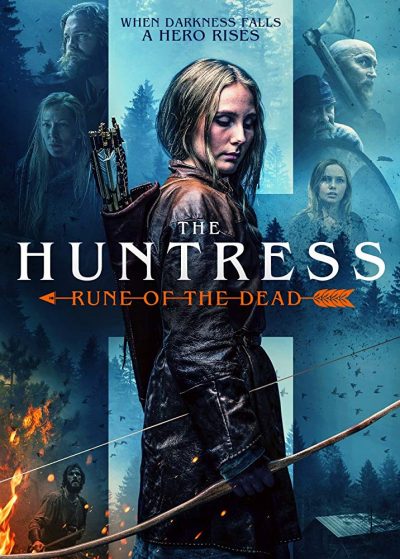 In 9th-century Scandinavia, teenage girl Runa (Stefansdotter) lives deep in the woods, with her mother, Magnhild (Idah), blind grandfather Ragnvald (Beck) and younger sister Bothild (Lyngbrant). Father Joar is notable by his absence, having gone off on a Viking raid to seek fortune for the family, and is now well overdue. However, he did at least train Runa to be a markswoman with the bow. Problems start when she finds a wounded warrior, Torulf, lying in the forest, and brings him back to their cabin, much against Magnhild’s wishes.
In 9th-century Scandinavia, teenage girl Runa (Stefansdotter) lives deep in the woods, with her mother, Magnhild (Idah), blind grandfather Ragnvald (Beck) and younger sister Bothild (Lyngbrant). Father Joar is notable by his absence, having gone off on a Viking raid to seek fortune for the family, and is now well overdue. However, he did at least train Runa to be a markswoman with the bow. Problems start when she finds a wounded warrior, Torulf, lying in the forest, and brings him back to their cabin, much against Magnhild’s wishes.
Torulf turns out to be a colleague of Joar’s, who tells a tale of the raiders looting a burial site – only to find vengeance coming out of the grave after them. He and Joar are the only two survivors. And when Joar returns shortly afterward, his arrival puts the whole group in peril, because of what’s inexorably following him. It’s only really at this point – two-thirds of the way in – that the film remotely begins to entertain. Up until this point, there has been a lot of sitting around the woods, and the director appears never to have heard of the maxim “Show, don’t tell.” Witness Torulf’s lengthy and frankly, boring, description of the situation, which would fit better into a Nordic saga recital than any cinematic retelling.
If the makers had gone for a siege type of film from the beginning, with the family barricaded in their cabin, and trying to fend off an unstoppable horde of barrow wights, this might have worked. It’s what I was expecting going in, and what I was waiting to see. And waiting. And waiting, while slow-moving coming of age family drama unfolded instead. I actually liked Stefansdotter in the lead role. Indeed, most of the performances are solid enough, and the same goes for the technical aspects. There was clearly some effort put in – the score, for example, is nicely done – and the forest provides a lushly appropriate backdrop against which any number of entertaining things might have unfolded. In a different, more interesting movie, anyway.
We finally do get the hand-to-hand (and hand-to-bow) battles for which we have been waiting. But only after a point by which the end credits would already be rolling on better-paced features. Even there, it is a bit on the dark side – though after my issues with Immortal Wars, the bar of what qualifies as “a bit on the dark side” has been raised considerably. This is nowhere near as bad, and you still can tell what’s going on, with a bit of peering. There’s a rough energy here which works, although the main impact is to make you wonder where the hell it has been for the rest of the movie. The makers should have sat down to watch the not-dissimilar Flukt, and built on what worked there, such as its steady flow of tension, instead of offering us 90 minutes of meandering around the woods.
Dir: Rasmus Tirzitis
Star: Moa Enqvist Stefansdotter, Yohanna Idha, Viva Östervall Lyngbrant, Ralf Beck
★★★
“Pack your bags, we’re going on a guilt trip!”
 History is largely filled with people being unpleasant to each other, usually for belonging to a different race, religion, nationality or even species [if you want to go back to the Cro-Magnons pushing out the Neanderthals about 40,000 years ago]. It’s sad and unfortunate, but it’s not something for which I feel personal responsibility – not least because it tends to work in both directions. My ancestors may have been part of the British Empire who, for example, invented the concentration camp in the Boer War. But my ancestors were also subject to the ethnic cleansing of the Highland Clearances, forced out to make way for sheep. Attempts to make me feel guilty for the sins of my forefathers are thus largely doomed to fail.
History is largely filled with people being unpleasant to each other, usually for belonging to a different race, religion, nationality or even species [if you want to go back to the Cro-Magnons pushing out the Neanderthals about 40,000 years ago]. It’s sad and unfortunate, but it’s not something for which I feel personal responsibility – not least because it tends to work in both directions. My ancestors may have been part of the British Empire who, for example, invented the concentration camp in the Boer War. But my ancestors were also subject to the ethnic cleansing of the Highland Clearances, forced out to make way for sheep. Attempts to make me feel guilty for the sins of my forefathers are thus largely doomed to fail.
And what we have here, is a well-crafted exercise in manipulation. It’s set in what is now Tasmania, then a penal colony where the British garrison were trying to maintain control, both of the prisoners and the indigenous population, using savage brutality against both. One of the former is Clare Carroll (Franciosi), an Irish woman convicted of theft who is now married to another prisoner and working in an army garrison. She is at the mercy of Lieutenant Hawkins (Claflin), who wields a letter of recommendation, which would give Clare and her family freedom, as power over her. Circumstances escalate to a night where she is raped and left for dead, while her husband and infant child are murdered. Hawkins leaves for the capital of Launceston, in pursuit of a promotion. Clare follows, intent on revenge, helped on the trail by Billy (Ganambarr), an Aboriginal tracker, who has also borne the brunt of colonial savagery in his past.
It’s effective, in the same way that a 2×4 across the head will get your attention. It’s not exactly subtle in the parallels being drawn between Clare and Billy, who have both suffered at the hands of the evil Brits, and who subsequently bond over their victimhood. Hawkins is such an evil swine, he might as well spend the entire film twirling his mustache. But despite being such an obvious attempt at generating outrage, it’s not without its merits. Franciosi delivers a fierce and intense performance, as someone who has lost everything, and so is prepared to go to any lengths to take revenge on those who destroyed her life.
Perhaps the most chilling sequence has her hunting down a soldier, already wounded in an encounter with the local population (which seems to have strayed in from an 80’s Italian cannibal film!). The savage way in which she takes him down and then beats his head to a pulp with her rifle-butt… Yeah, she is clearly highly motivated. However, the simplistic way in which white men are, almost without exception, portrayed as stereotypical villains undoes much of the good work put in by the actors, and dampens its overall effectiveness.
Dir: Jennifer Kent
Star: Aisling Franciosi, Baykali Ganambarr, Sam Claflin, Damon Herriman
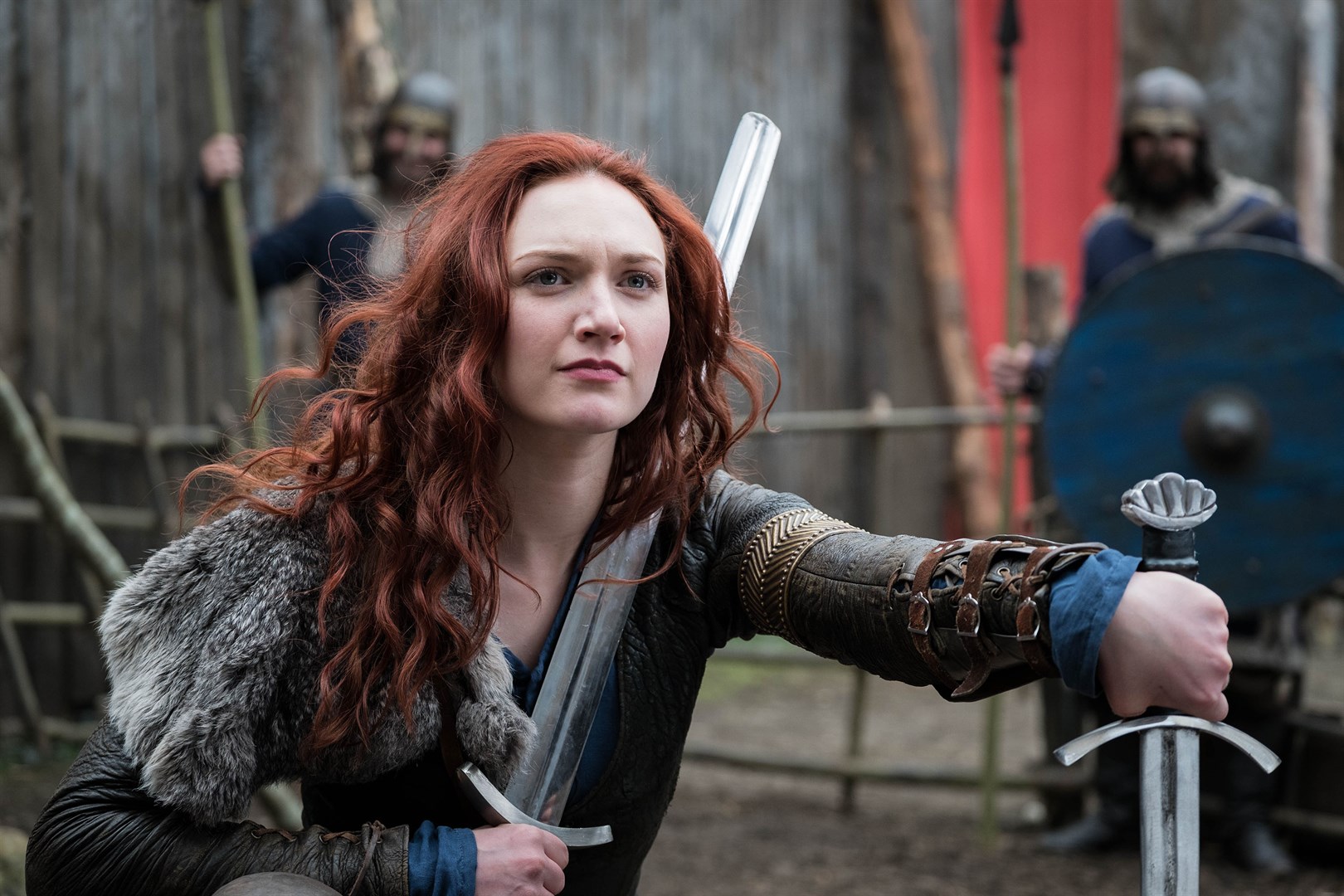 ★★★
★★★
“Low-rent vikings”
The success of Vikings has spawned its fair share of similarly set films, and this isn’t the first such to stray into our purview, following Viking Siege. As there, it’s clear that the budget isn’t anywhere near its television inspiration. As a result, these films have to work harder in other areas, to make up for what they can’t offer in spectacle. Siege did this by mostly taking place in a single location. Destiny tries (and fails) to be at least occasionally epic, but benefits by having a genuine action heroine, front and centre. Not quite Lagertha, perhaps, yet close enough to be a pleasant surprise.
It’s Helle (Demetriou), who was the daughter of King Asmund of Volsung, swapped out for a male child, due to heir-related reasons. However, her replacement has grown up neither interested in, nor suitable for, leadership, while Helle has turned into a bit of a bad-ass. After Asmund’s death, his brother Bard (Nieminen) tries to take the throne, framing Helle for the murder of the official heir. She manages to escape, and with a little guidance from Odin (Stamp, who must have needed a house car TV payment or something), prepares to claim her rightful place on the throne of Volsung. Meanwhile, Bard has some divine guidance of his own, in the shape of Loki (McArthur).
The paucity of resources available is most painfully apparent during the final battle for the kingdom, which clearly has little more than a football team (plus substitutes) taking part on each side. Unless Volsung is smaller than San Marino, they shouldn’t have bothered. Considerably more successful are the one-on-one fights, such as Helle’s battle against one of a pair of hulking giant killers (note, no hyphen!), both played effectively by 6’8″ body-builder Martyn Ford. Demetriou has a fast, athletic style in combat, which is a nice contrast to the brute strength used by her far larger opponent. Generally, though, she looks and acts her part very well: as mentioned, maybe Lagertha Lite, yet a worthy shield-maiden, none the less.
The supporting cast may err on the side of panto, Nieminen and McArthur in particular, yet this doesn’t feel particularly inappropriate, given their villainous nature. Rather less interesting are the low-rent hippies with whom Helle joins up in her wandering through the woods. They show up to spout pacifist philosophy and drink fermented turnip juice (!), before mysteriously acquiring weapons and the skill to use them – just in time to slaughter and be slaughtered in the final battle. Pacifism: it’s vastly over-rated…
But when it sticks to the smaller scale, and its heroine in particular, this is by no means terrible, providing your expectations are similarly restrained. In some ways, it seems like a throwback to similar British sword and sorcery flicks of the early eighties. from polished entries like Excalibur, down to the cheap ‘n’ cheerful (yet not necessarily less fun) end represented by Hawk the Slayer. That’s not entirely a bad thing, in my humble opinion.
Dir: David L.G. Hughes
Star: Anna Demetriou, Timo Nieminen, Murray McArthur, Terence Stamp
a.k.a. Of Gods and Warriors
★★★
“Full of hot air.”
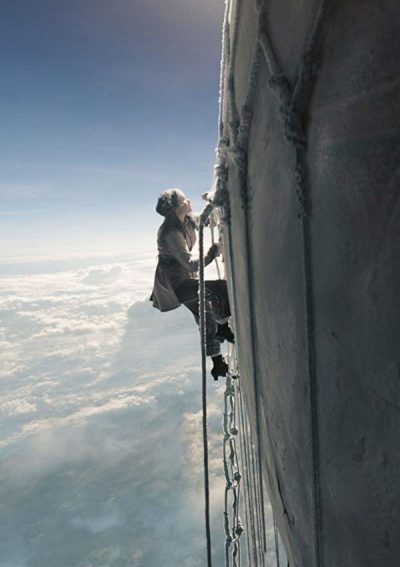 I was genuinely stoked when I got to the end of this one, which details the derring-do of 19th-century pioneers James Glaisher (Redmayne) and Amelia Wren (Jones). The former is a scientist in the fledgling field of meteorology, who wants to obtain data from the upper atmosphere. The latter is a balloon pilot, carrying on despite the death of her husband on a previous flight. Together, they team up, to fly higher than any person had ever gone before. Indeed, further than even they wanted to go, as a frozen valve prevents them from descending when they need to do so. With Glaisher out of commission through oxygen deprivation, it’s up to Wren to climb, by herself, up the outside of the balloon, in order to reach the top and clear the valve.
I was genuinely stoked when I got to the end of this one, which details the derring-do of 19th-century pioneers James Glaisher (Redmayne) and Amelia Wren (Jones). The former is a scientist in the fledgling field of meteorology, who wants to obtain data from the upper atmosphere. The latter is a balloon pilot, carrying on despite the death of her husband on a previous flight. Together, they team up, to fly higher than any person had ever gone before. Indeed, further than even they wanted to go, as a frozen valve prevents them from descending when they need to do so. With Glaisher out of commission through oxygen deprivation, it’s up to Wren to climb, by herself, up the outside of the balloon, in order to reach the top and clear the valve.
The in-flight entertainment is excellent, right from the take-off, in front of a sizable crowd of onlookers, to whom Wren is delighted to play. But as they rise up, you do get a real sense of the appeal of flight, in a way which feels almost like a Hayao Miyazaki film. That matters, having gone into this wondering why someone would willingly dangle from a wicker basket, below what is effectively a large bomb (here, lifted by inflammable coal gas). But the beauty of the air is well-captured, as well as its immense scale, with any number of shots depicting the giant balloon reduced to little more than a speck, beside the massive clouds. And Wren’s solo ascent is the stuff of heroic legend.
But that’s also the problem. For she never existed. Oh, Glaisher did. And so did his flight, in 1862. It set an altitude record for any craft of 36,000 feet, which would endure for more than sixty years. And after Glaisher lost consciousness, his companion did end up needing to pull the release valve by mouth, having lost all feeling in his limbs. Yeah: his. Because it was professional balloonist Henry Coxwell who was the hero in fact. Now, I get that cinema will play fast and loose with facts. But swapping out a real person for a fictional one of the opposite gender? Really? There weren’t any actual aeronautical heroines about whom a film could be made? Oh, hang on: there were. Most obviously, Sophie Blanchard, a Frenchwoman on whom the character of Wren was partially-based, and who was Napoleon’s head of aeronautics. A future feature on her may beckon.
The more grounded stuff in the film also doesn’t work as well. There’s a narrative conceit which holds back information about the circumstances surrounding Mr. Wren’s death. And background stuff on Glaisher’s struggles to raise funds for his expedition into the sky, as well as his relationship with his father (Courtenay), don’t add much to proceedings. I’d have been happier with a real-time recounting, purely focused on the flight up and down. The contrast between the staid Glaisher and show-womanship of Wren, offers enough fuel to keep things going, until the latter’s perilous ascent is needed. Just don’t ask why neither of them thought to pack a pair of gloves.
Dir: Tom Harper
Star: Felicity Jones, Eddie Redmayne, Himesh Patel, Tom Courtenay
★★★½
“Can’t see the forest for the Nazis”
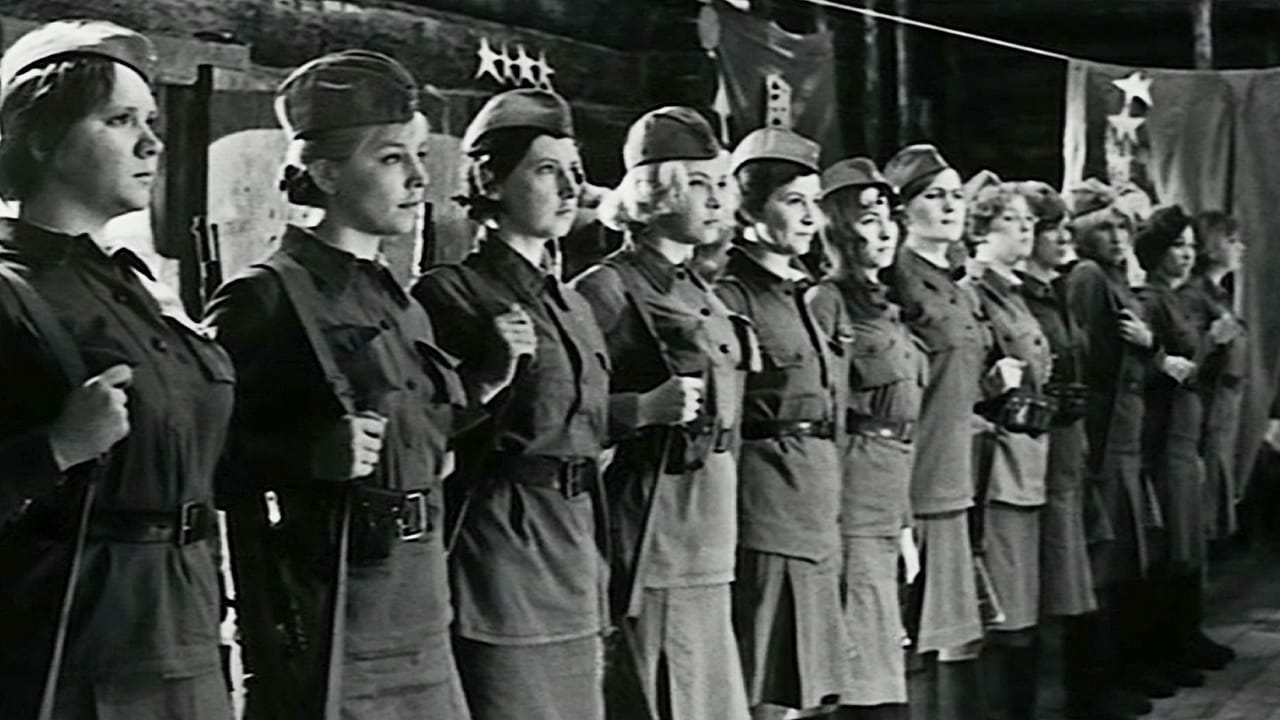 It’s the summer of 1942, and Soviet forces are facing the invading German Army. After Sergeant Major Vaskov (Martynov) requests soldiers for his anti-aircraft battalion who won’t get drunk and molest the local women, he gets what he wants. Except, the new arrivals are an all-female squad of soldiers, with whom Vaskov is initially singularly ill-equipped to deal. However, they prove their mettle, led by the efforts of Rita Osyanina (Shevchuk), and eventually win Vaskov’s respect. While returning to the barracks one night, Rita stumbles across two Nazi paratroopers; she, along with four colleagues and Vaskov, form a search party, and head deep into the surrounding forest to capture the Germans. However, they discover the real force is significantly bigger, and must begin a guerilla warfare campaign to disrupt the enemy’s mission, harrying them through the wooded and marshy terrain.
It’s the summer of 1942, and Soviet forces are facing the invading German Army. After Sergeant Major Vaskov (Martynov) requests soldiers for his anti-aircraft battalion who won’t get drunk and molest the local women, he gets what he wants. Except, the new arrivals are an all-female squad of soldiers, with whom Vaskov is initially singularly ill-equipped to deal. However, they prove their mettle, led by the efforts of Rita Osyanina (Shevchuk), and eventually win Vaskov’s respect. While returning to the barracks one night, Rita stumbles across two Nazi paratroopers; she, along with four colleagues and Vaskov, form a search party, and head deep into the surrounding forest to capture the Germans. However, they discover the real force is significantly bigger, and must begin a guerilla warfare campaign to disrupt the enemy’s mission, harrying them through the wooded and marshy terrain.
In contrast to larger epics, it’s a very small-scale, up close and personal approach to the war, taking place well away from the front lines. Released in two parts (though at 188 minutes, it’s less then twenty longer than Saving Private Ryan), the first section takes place at the anti-aircraft emplacement. The action there is mostly far overhead, and in the early going, it is a little tough to separate the rush of similar-looking women to whom we are suddenly introduced. Though I did like the stylistic approach of having the war take place in harsh black and white, while the soldiers in more peaceful times are depicted in colour, with an almost dreamlike version of reality.
When we get to the meat of the story, the film improves significantly. It’s fairly standard “small group taking on a larger force” stuff, a topic which has been mined frequently for war movies, from Zulu and The Alamo through Ryan to 300. Yet it’s still effective to follow Vaskov and his handful of untested soldiers, as they go into battle with far more experienced warriors. Quite deliberately, the enemy are kept almost faceless, given no humanity at all: their speech is left unsubtitled, for instance. As the losses mount inexorably, there’s a genuine impact to them, and you’re left with an up-close and personal look at war and the human cost it has. Yet at the end, a radio broadcast casually dismisses the preceding three hours of heroic sacrifice with, “During the day of June 3rd, no major engagement took place on the front. However, some minor local fighting occurred in certain sectors.”
Based on Boris Vasilyev’s 1969 short novel of the same name, there was also a 2015 mini-series for Russian television (a review of that is coming soon); a Tamil-language Indian film (Peranmai); a Chinese TV series; and more unusually, the story was turned into not one but two operas, one in Russia and the other in China. However, this version was nominated for the Best Foreign Film Oscar, where it lost out to Luis Buñuel’s The Discreet Charm of the Bourgeoisie. No death before dishonour there.
Dir: Stanislav Rostotsky
Star: Andrey Martynov, Irina Shevchuk, Yelena Drapeko, Yekaterina Markova